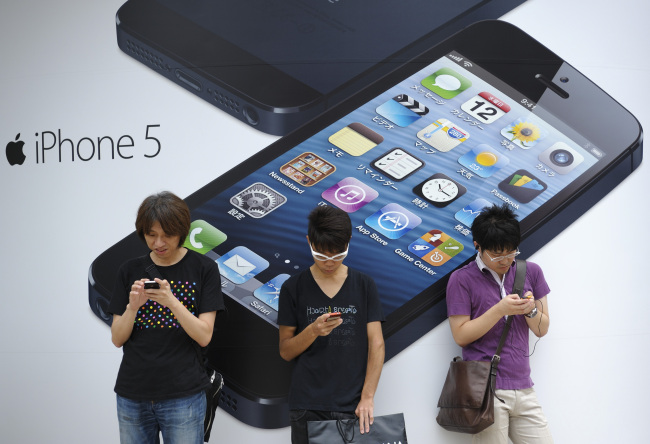The smartphone has crossed the line from shiny new technology to ubiquitous commodity.
App-laden, Web-surfing phones have surged in popularity over the past half-decade and generated $293.9 billion in sales last year alone. They are now used by more than 1 billion people around the world. With more than half of mobile users in the U.S. and developed countries owning a smartphone, and consumers in emerging markets including China and India gravitating toward cheaper models, demand is slowing for high-end devices.
The average price of a smartphone has plunged to $375 from $450 since the beginning of 2012, IDC estimates. That drop has already threatened revenue growth and profit margins at Apple Inc. and Samsung Electronics Co., and could further squeeze companies like Nokia Oyj and BlackBerry that were counting on new products to revive sales. Beneficiaries include up-and-comers, such as Huawei Technologies Co. and Lenovo Group Ltd., which specialize in low-priced gear.
“The days of great growth in the high end of the market are gone,” said Michael Morgan, an analyst at ABI Research. “It’s the Chinese companies who know how to survive on tiny margins that are ready for the fight that’s about to ensue.”
 |
People stand outside a store advertising the iPhone 5 in Tokyo. (Bloomberg) |
The decline in average smartphone prices is akin to what happened in the personal-computer industry in the late 1990s, according to former EMachines Inc. Chief Executive Officer Stephen Dukker. Back then, millions of people who wanted to get online for the first time snapped up cheap new PCs from EMachines and other low-cost providers, dragging down once-stable PC prices to $1,026 in 2002 from $1,898 in 1996, according to IDC.
Apple, Samsung and other companies relying on sales of expensive phones are already feeling the pinch. In June, Samsung lost more than $25 billion in market capitalization, greater than the value of Sony Corp., as analysts trimmed projections for Samsung’s high-end Galaxy S4 smartphone, which costs $200 when sold as part of a two-year wireless package, or about $630 without a carrier subsidy.
“The market is becoming less about speeds and feeds, and more about price,” said Kevin Restivo, an analyst at IDC in Toronto. “More people don’t need to be overwhelmed by a phone, so long as it’s good enough.”
HTC Corp., Taiwan’s largest smartphone maker, missed analysts’ sales and profit estimates for its second quarter amid disappointing sales of its HTC One handset, which costs $200 with a package, or $600 to $700 without one. On July 12, carriers cut the price of BlackBerry’s poor-selling Z10 to $50 from $200 ― just six months after it was introduced.
Apple, based in Cupertino, California, is predicted to report on July 23 that fiscal third-quarter revenue was little changed from a year earlier, based on the average of analysts’ estimates compiled by Bloomberg, mainly because of slowing iPhone sales. That would be the worst sales performance since 2003’s second quarter, when revenue declined 1.3 percent.
T. Michael Walkley, an analyst at Canaccord Genuity Inc., last month lowered his estimate for iPhone sales for fiscal 2014 to 173 million from 181 million. Natalie Kerris, a spokeswoman for Apple, declined to comment on iPhone sales.
Falling prices and the popularity of products with lower margins such as the iPad mini are beginning to hit Apple’s profitability. While the company makes a gross margin of more than 50 percent on the iPhone 5, sold for more than $600 to carriers, it has sold millions of older models in recent years at lower prices at a gross margin of 35 percent or less, according to Brian Marshall, an analyst at ISI Group. Apple’s gross margin fell to 37.5 percent in the period that ended in March, from 47.4 percent a year earlier.
Apple shares have dropped 39 percent from a record in September amid concerns of slowing iPhone growth and declining margins. They declined 1.6 percent to $424.95 on July 19.
While any innovations may slow the drop in prices ― for example, Apple, Samsung and others are working on wearable, wristwatch-like device, which could stoke sales ― most people are content with the size, shape and features of basic smartphones, ABI’s Morgan said.
Morgan predicts Apple will introduce an iPhone 5S this September that could come in different colors and feature a fingerprint reader so owners wouldn’t have to remember a security code. That won’t be enough to revive iPhone sales growth for long, he said.
More of those profits will be won in emerging markets, where many consumers have yet to buy their first smartphone. IDC’s Restivo predicts that 66 percent of the 384 million smartphones sold in China next year will cost less than $200, compared with 14 percent of the 153 million phones projected to be sold in the U.S.
China-based suppliers of less-expensive phones, such as Huawei, have been gaining market share, mostly by undercutting HTC, BlackBerry and Nokia on price. Even as its phones priced as low as $100 sell briskly, Huawei’s two-year-old devices unit is profitable, Shao Yang, the company’s vice president of marketing, wrote in an email.
Lenovo has used the same low-price strategy that has made it the world’s largest PC maker to become the fastest-growing smartphone maker in China, said J.D. Howard, vice president of operations and business development for Lenovo’s smartphone, tablet and TV unit.
“It really works in the smartphone business, because some of our rivals have been charging a ridiculous premium,” he said.
(Bloomberg)








